Using Nature-based Solutions for Resilience and Wildlife
by Dr. Lenore Tedesco, Executive Director
The Wetlands Institute is a research, conservation and education facility that was intentionally built at the coastal interface. Our location at the marsh interface has served us well for more than 50 years. Unfortunately, the Institute, is not very resilient and faces increasing risks to our sustainability. Many of you know about our ground-breaking work of the Seven Mile Island Innovation Lab. This partnership between the US Army Corps of Engineers, the NJ Department of Environmental Protection, and the Institute has successfully restored more than 100 acres of marsh, and after the successful marsh restoration project at Scotch Bonnet Island (see wetlandsinstitute.org/7MTSB), we are turning our attention to the Salt Marsh Trail at the Institute.

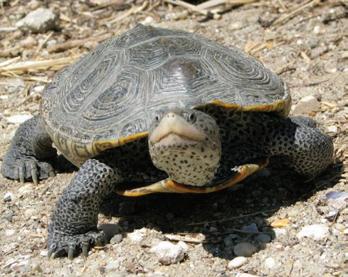
The trail elevation averages four feet. In 2000, the trail flooded twice per year; in the last 5 years, the trail has flooded more than 330 times; an average of 67 times per year! This flooding kills mature trees, floods terrapin and bird nesting areas, and limits access and education programs.
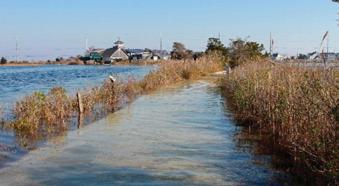
The Salt Marsh Trail Revitalization Project aims to raise the elevation of the salt marsh trail to enhance educational opportunities and visitor programs that are being impacted by flooding. It will preserve our access to the dock and boathouse for research programs, and will use nature-based solutions to recreate important habitats for marsh dependent species, especially diamondback terrapins and coastal birds. This project embodies a vision to do better by implementing an innovative ecosystem-based approach.
The project design calls for raising the elevation of the Salt Marsh Trail by two to three feet (up to a total height of 6 feet), widening the trail to better accommodate programs; replacing the boat house with a modest structure, and creating new high marsh and habitat specifically designed for diamondback terrapin nesting and coastal birds. Raising
the road will involve roughly 13,000 cubic yards of fill previously dredged in 2017 and stored by the Borough of Avalon. Using this fill returns stored sediment to the coastal zone where it belongs.
The grade from the newly elevated trail to the surrounding marsh is being designed in a way that will restore marsh habitat that has been lost to flooding in the past 20 years. In all, we expect to restore approximately 5 acres of lost marsh. The trail will be replanted with native trees and plants, intentionally selected and using planting palettes that will maximize the benefit to the marsh ecosystem. We are also creating an important barrier to storm waves, conferring additional resilience to the Institute campus.
We were awarded a grant from the National Fish and Wildlife Foundation in partnership with NJDEP for the planning phases of the project. Working with AKRF civil engineers and the University of Pennsylvania, we developed models for risk analysis and projections of landscape change. With the planning phase complete, permits for the work have been submitted to the appropriate state and federal entities. We are applying for grant funds for the construction phase of the project and hope to begin work in the fall of 2026.
We are excited to be applying innovative tools to a project in our home so that we can build coastal resilience, enhance educational opportunities, improve access for visitors, and benefit wildlife into the future.
Deborah A. Hays, Chair
James Donohue, Vice-Chair
Hank Schellenger, Treasurer
Annie Ulichney, Secretary
Raymond Burke
Timothy Jon Clay
John Flynn
William Hankowsky
Margaret McAllister
John Millar
Staff
Leadership
Jeannie Morris
Liz Thomas
Jon Tullis
Amy Welsh
William Wermuth
Francis J. White III
Dr. Lenore Tedesco, Executive Director
Dr. Lisa Ferguson, Director of Research and Conservation
Jim Frick, Director of Finance and Operations
Brooke Knapick, Director of Educational Program Development
Research & Conservation
Julie Blum, Research Scientist
Samantha Collins, Research Scientist
Meghan Kolk, Conservation Scientist
Bailey Sanders, Research & Conservation Coordinator
Brian Williamson, Research Scientist
Education
Francesca Jacobs, Environmental Educator
Abbygayle Liles, Aquarist/Environmental Educator
Erin Rawls, Outreach Coordinator
Development & Communications
Leah Satterfield, Development Associate
Sarah Davidson, Social Media Specialist
Finance
Terrie Campbell, Finance Administrator
Christine Whaley, Finance Analyst
Administration
Mary Beth Ciccarone, Administrative Coordinator
Kimberly Dmytro, Tidepool Shop Manager
Michael Fridmann, Facilities Manager
Visit Us
Hours: Starting September 20, open
Saturday and Sunday 9:30 to 4:30. Check our website for Holiday Hours.
General Admission: Members: Free.
Non-members: $12 Adults, $10 Children 4-12.

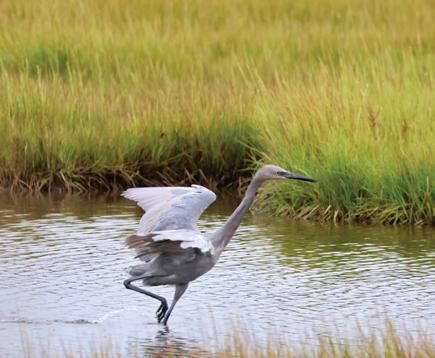
Marsh M usings Change: The Constant that Drives Excellence
by Dr. Lenore Tedesco, Executive Director
As a wetland scientist, I have come to understand that change is a fundamental aspect of coastal systems. Everything about them is attuned to change. They use change to strengthen themselves and flourish.
At The Wetlands Institute, we too face the need for change. We are situated at the coastal interface, where we can create the most significant impact. This also means we are deeply tied to the changes in the surrounding marsh. Our program growth has us bursting at the seams. Our programs and infrastructure are being stressed by the climate challenges we face, and our marshes are being negatively impacted by sea level rise.
Over the past decade, The Wetlands Institute has elevated our stature and through our innovative work we have focused on addressing these challenges. We have made no small plans and are now positioned to embrace change once again. It is our intent to flourish in the face of change.
We are in the midst of a multi-year planning process. We continue to stabilize and enhance the marshes that are foundational to our home and community. We have completed planning and design for a project to elevate the Salt Marsh Trail (see cover article), submitted grant applications, and begun renovations at our Mainland Campus. We continue to reimagine our marsh home and will share more as these plans take shape, as we honor our past while looking forward to a vibrant future.


A Special Note from TWI: Leading ReTURN the favor walks requires specialized volunteer training and permits. If you would like to become a trained ReTURN the Favor volunteer, please visit https:// returnthefavornj.org/. Each May, TWI posts a variety of volunteer opportunities, and we hope you will join us in our conservation work next summer.
A Share d Purpose: Helping an Ancient Specie s Survive
by Abe & Linda Littenberg
The Wetlands Institute’s mission spans research, conservation, and education, but one of its most hands-on efforts is reTURN the Favor. Launched in 2014, this program organizes volunteers to rescue stranded horseshoe crabs along New Jersey beaches.
Each May and June, female crabs come ashore to lay eggs, with males in tow. Waves often flip the crabs onto their backs, leaving them exposed to predators and the sun. With populations already stressed by overharvesting and habitat loss, every rescue matters. Horseshoe crabs play a vital role in both human health and the natural world. Their blood provides Limulus Amebocyte Lysate (LAL), essential for testing vaccines, injectable drugs, and medical devices for contamination. Their eggs also fuel epic migrations of shorebirds such as Red Knots, which depend on this rich food source to travel from South America to the Arctic.
As trained volunteers, we lead evening outings to closed beaches when birds are not present. Groups ranging from schoolchildren to adults help flip hundreds (sometimes more than a thousand!) crabs in a single night. Participants often find the experience both eyeopening and rewarding, learning firsthand about the link between crabs, shorebirds, and people.
For us, these nights feel magical: quiet beaches, starry skies, and the shared purpose of helping an ancient species survive. Though the work can be tiring, we are proud of the work we do.
The Power of Giving Together
by Liz Hefner, Development Team
We are truly grateful for the generous support we have received this year. Our mission to promote appreciation, understanding and stewardship of wetlands and coastal ecosystems through our programs in research, conservation, and education is strengthened through the generosity of friends like you.
Your gifts help our scientists lead innovative work to restore the marsh and track changes in fragile habitats, guide our conservation staff in protecting horseshoe crabs, diamondback terrapins, coastal birds, and countless other species. It enables our educators to open the minds of people of all ages to the wonders of the natural world. Every act of giving strengthens the connection between people and nature, ensuring these marshes and our coastal communities will thrive for generations to come.
Philanthropy here is not just about dollars; it is about shared purpose. When you choose to support The Wetlands Institute, you join us in our groundbreaking science, support our conservation ethic as we care for our coastal ecosystems, inspire the next generation of environmental stewards, and foster a community rooted in appreciation for nature.
As we look ahead to spring and the renewal it promises, we are grateful to know we do not walk this path alone. Together, we are creating a future where wetlands continue to be a source of wonder, resilience, and life.
Thank you for being part of this mission.
Aquarist’s Corner: Meet the Striped Burrfish
by Abbygayle Liles, Aquarist/Environmental Educator
I am excited to share some quick facts and clear up some misconceptions about one of our long-time residents in our Secrets of the Salt Marsh Aquarium, the striped burrfish.
But of course, we can’t talk about the burrfish without also bringing up a relative from the order Tetraodontiformes, the northern puffer. Burrfish are commonly confused with their puffer cousin, but while both considered “pufferfish”, they are in two separate families. Both the puffer and burrfish take in water to puff their body when threatened, but the burrfish has permanently erect spines as a mechanism of defense, while the puffer does not. Both these species have beak-like fused teeth which allow them to crush hard pieces while they eat. More specifically, burrfish have two fused plates, one on top and one on the bottom of their mouth, while the puffer has four plates, two on top and two on the bottom. Burrfish need this large crushing plate due to their diet, which consists of mussels, clams, crabs, and even small fish. Since burrfish are not the strongest swimmers in the ocean they must rely on their defense mechanisms (puffing and erect spines) to deter predators. Luckily, most predators steer clear as these adorable sea blimps cruise through the seagrass beds searching for their next meal.
You can learn more about the striped burrfish by visiting the Virtual Watch Tank portion of the Virtual Wetlands Experience at https://wetlandsinstitute. org/aquarium-bytes/.

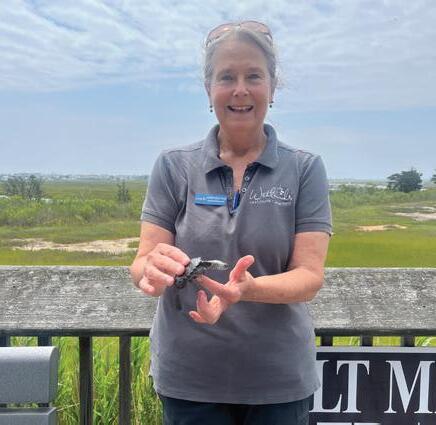
Reflections from a Seasonal Naturalist
by Karen Hedstrom, Seasonal Naturalist
My work as a Seasonal Naturalist is fun and incredibly important. Fun because I am where I want to be. Outside, feet in the mud and sand, breathing salt air, searching skies, mudbanks and shallows for evidence of life. Pinch me! It’s so good! Important because the students with me are also soaking it in. They are the future scientists, lawmakers, homeowners and parents of the world. It is my job to excite their fascination and connection with the natural world, encouraging them to live a life of stewardship.
I was born into a family of educators whose love for the Jersey shore exposed me from an early age to the secrets and stewardship of the salt marsh and ocean shores. After spending many hours as a microbiologist in the lab, I evolved into an environmental educator who is fascinated by the very small parts of animals and how their lives work, and I enjoy sharing these insights with students. Like the awesome life history of the horseshoe crab: unchanged body and habits for eons, multiple molts over a dozen years to grow to maturity. Isn’t this emblematic of humans? Don’t we shed and grow? Become more of ourselves over our lives? After hundreds of millions of years, can you imagine the things they have seen? Ice ages, extinctions, continental drift, the start of humanity, societal and technological advances… and mistakes. What lessons can we learn from horseshoe crabs who so far survive the mayhem? Don’t fix what isn’t broken. Be adaptable, flexible, live simply, take little and give a lot. Lessons learned. It’s all pretty cool!


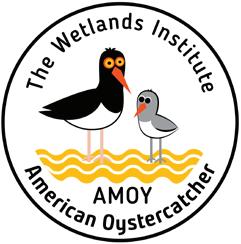
A New Study of American Oystercatchers in Our Salt Marshes
by Dr. Lisa Ferguson, Director of Research and Conservation
This fall our staff launched an exciting new project to learn more about the population of American oystercatchers in the salt marshes of New Jersey. Though this mediumsized shorebird with its can’t-miss orange-red bill is most often associated with our beaches, many pairs nest and forage throughout the salt marsh. They are more challenging to find and to study in these tidal grasslands, and so we know less about their habits and success. We will be partnering with Conserve Wildlife Foundation of New Jersey and Stockton University and receiving help from Cape May County Technical High School and a group of talented volunteers over the next year to learn more about these marsh-nesting oystercatchers and their conservation needs. This work is funded by the National Fish and Wildlife Foundation through their Atlantic Flyway Shorebird Initiative Program. You can support it too through our American oystercatcher adoption program and by learning about these shorebirds through our outreach and shorebird steward programs!
Connecting the Dots of Migration: The Motus Station at The Wetlands Institute
By Sarah Davidson, Social Media Specialist
Motus, led by Birds Canada, is an international research community focused on supporting wildlife conservation through their system of global “bird radar” which helps scientists track the journeys of migrating animals. Over 2,200 Motus antenna towers are strategically placed to detect signals from animals carrying tiny, lightweight nanotags along key “bird highways” like the Atlantic Flyway. A Motus station on the boathouse at The Wetlands Institute was recently updated by the American Bird Conservancy. These upgrades allow The Wetlands Insitute to continue contributing to vital data that help researchers study flight paths and critical “rest stop” habitats used by migrating birds, bats, and insects. As many species face threats like habitat loss, this information is key to protecting them so they can continue their amazing migrations for generations to come.

The Wetlands Institute Honored for Leadership in Terrapin Conservation
By Sarah Davidson, Social Media Specialist

Research and Conservation scientists at The Wetlands Institute were honored with the Community Conservation Award at the 10th Triennial Diamondback Terrapin Working Group Workshop (DTWG) in Cape May this October. The award recognizes organizations demonstrating long-term, meaningful efforts in terrapin education and conservation.
Community has always been central to our success. For decades, our staff, interns, and volunteers have worked with local partners to protect terrapin populations through research, outreach, and habitat conservation. We’re proud to be recognized by DTWG, a respected leader in terrapin conservation, and grateful for this member-nominated honor.
Our efforts include population monitoring, nest protection, road-crossing patrols, barrier fencing, and rescuing and incubating eg gs from road-killed females. Through research, education, and community science, we engage thousands each year in terrapin conservation.
This award celebrates the impact of our dedicated team and partners, past and present, and reaffirms our commitment to protecting diamondback terrapins.


Scotch Bonnet Island Marsh Enhancement Update
By Dr. Lenore Tedesco, Executive Director
The Wetlands Institute, along with our project partners at the U.S. Army Corps of Engineers (USACE) – Philadelphia District, USACE – Engineer Research and Development Center (ERDC), and the NJDEP Fish and Wildlife team, continue to monitor the restoration project along Stone Harbor Boulevard. We are pleased to report that the marsh is responding extremely well.
To save Scotch Bonnet Island from drowning, we raised the marsh using 23,000 tons (14,000 cubic yards) of clean sediment dredged from the NJ Intracoastal Waterway near Nummy Island. The 5.5-acre placement lifted the marsh about two feet above the surrounding plain, with layers up to three feet thick.
We are pleased to see strong growth of Spartina marsh grass and pickleweed on the formerly barren mud. The higher ground is attracting abundant shorebirds, gulls, and wading birds—including rare visitors like Reddish Egret, American Golden Plovers, and American Avocets. The site has quickly become a birding hotspot, drawing enthusiasts from near and far.
Cutting-edge research and monitoring continue with partners from the U.S. Naval Academy, University of Pennsylvania EM Lab, and USACE-ERDC. We’ve shared findings through numerous programs and presentations to guide future marsh restoration. Stay tuned as the site evolves.
It's the season of giving, and the Tidepool shop has the perfect selection of Wetlandsinspired gifts.
These handmade stained glass and metal suncatchers would make a window glow, even in the heart of winter. The long stained-glass pieces catch the sunlight and draw the eye to the beautifully detailed handmade pewter features, bringing the sea into your home this holiday season.
Or if you are looking for something more unique, these handmade metal ornaments are perfect for any art or nature lover. These whimsical ornaments would brighten up any space.
And don’t forget to stay warm this winter. This cottonrich hoodie featuring a Full Moon Horseshoe Crab design created by our own Tidepool Shop Manager and screen printed locally at Flying Fish Studio in Cape May is perfect for those beach walks on cold winter days.
If you are looking for more gift ideas, the Tidepool Shop is open on Saturday and Sunday, 9:30 AM – 4:30 PM, so stop by and check out all of the other great ideas we have!

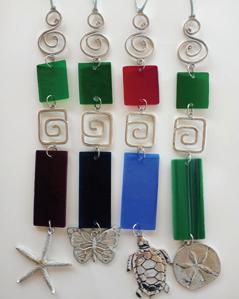

Don’t forget you can shop online too at https://tidepool-shop.myshopify.com/.

Winter Happenings
As the stillness of colder temperatures sets in, join us all winter long for activities on the marsh every Saturday and Sunday. Unless otherwise stated, all activities are free with admission and occur onsite at The Wetlands Institute. For the most up-to-date information, visit wetlandsinstitute.org/events.
Science Activities
Each month we will offer a new self-guided science activity related to seasonal changes in nature. We provide the supplies, and you create the learning!
Help us feed the local marine life! We will open feeding once a week so you can see the burrfish eating crabs and the horseshoe crab gobbling shrimp.
During this live animal presentation, get up close with turtles, fish, crabs, sea stars and urchins, plankton, mollusks, horseshoe crabs, or the popular animals of Finding Nemo. After the presentation, create your very own take-home craft.
Join us as we explore conservation issues ranging from Bats to Seafood to Terrapins, or dive deeper into the lives of the LenniLenape and the unseen world of Ultraviolet-induced Visible Fluorescence and Plankton or uncover the hidden dangers of Marine Debris and Climate Change.
Learn about local creatures found in the salty waters of the ocean or back-bay! Join an Institute educator for a unique, interactive learning experience as they teach about whelk, sea urchins, sea stars, mud snails, horseshoe crabs, and more!

1075 Stone Harbor Blvd.
Stone Harbor, NJ 08247-1424
A non-profit organization studying, preserving, and protecting wetlands and coastal ecosystems
A non-profit organization studying, preserving, and protecting wetlands and coastal ecosystems

As a conservation organization, we have a special responsibility to address the global challenges of climate change and sustainability. We are committed to minimizing environmental impacts in all aspects of our operations. Visit our website at wetlandsinstitute.org/about-us/ sustainability/ for more on our sustainability initiatives.
Views from theTower
Recharging and Protecting
This year, many of us have spent time recharging in nature. Whether bird watching in the backyard, walking the beach, or exploring the marsh, we experienced the peace that nature brings.
Wetlands Institute’s
At the same time, we have also witnessed increasing threats to our marshes, coastal ecosystems and communities, including sunnyday flooding, the relentless cycle of beach erosion, and powerful coastal storms. Doing nothing is no longer an option. That’s why we are taking action like our work on Scotch Bonnet Island, where marsh grasses are thriving and birds are finding refuge.
We know it is in your nature to act, and your past support has allowed us to deliver innovative education programs that connect people of all ages to the natural world, implement innovative solutions to support our marshes and coastal communities, and it enabled us to train the environmental leaders of tomorrow. As you consider your year-end giving, we hope you will make a gift today to help us continue protecting and restoring the marshes and coastal ecosystems we all cherish. Your generosity makes this work possible—and your support truly makes a difference.
Thank you for being an integral part of The Wetlands Institute family and for playing a vital role in caring for our coastal environment for generations to come.
Yes! I want to support The Wetlands Institute!
$500
3 Simple Ways to Give:
• Call 609.368.1211 to donate by phone,
• Complete and mail to: The Wetlands Institute, 1075 Stone Harbor Blvd, Stone Harbor, NJ 08247, or
• Donate online at wetlandinstitute.org/donate
My check payable to The Wetlands Institute is enclosed. Place a one-time gift on my credit card for $
Bill my credit card $ Monthly Quarterly Annually
Place a one-time gift on my credit card for $ My/my spouse’s employer or company will match my gift.
CREDIT CARD: Visa Mastercard AMEXDiscover
Name as it appears on card
I have already included The Wetlands Institute in my will or other estate plan. (Please let us know so we can welcome you into the Herbert Mills Legacy Society.)
I would prefer an email receipt acknowledging my donation.
